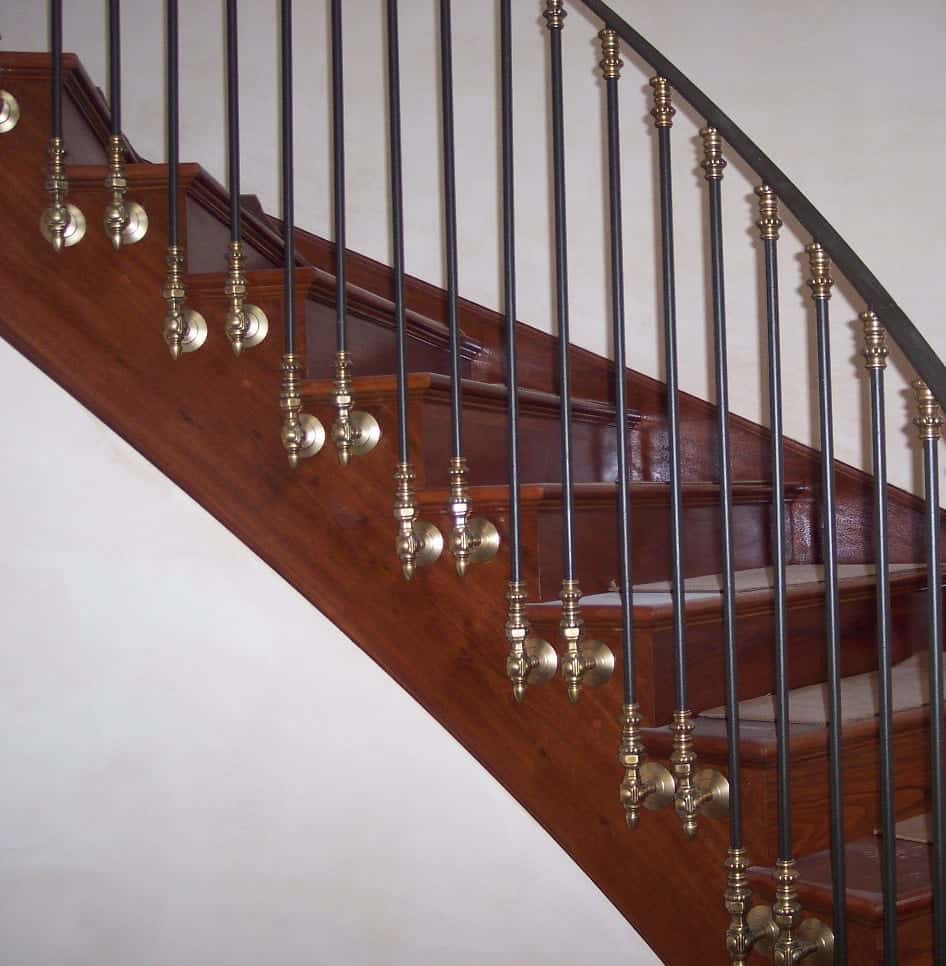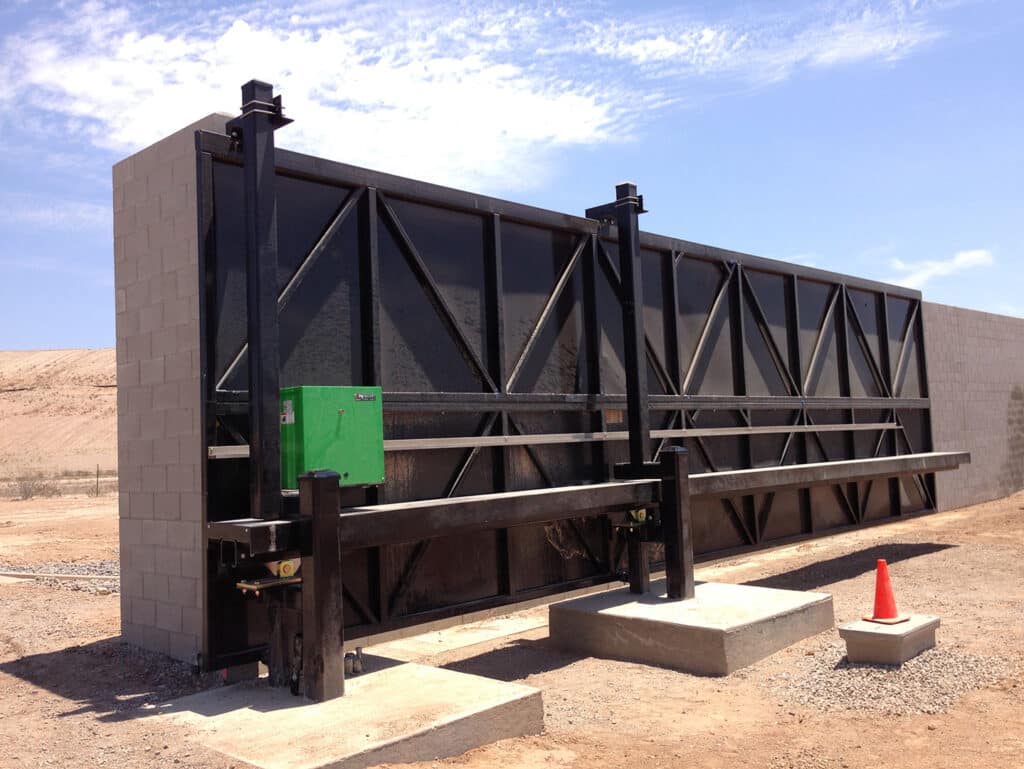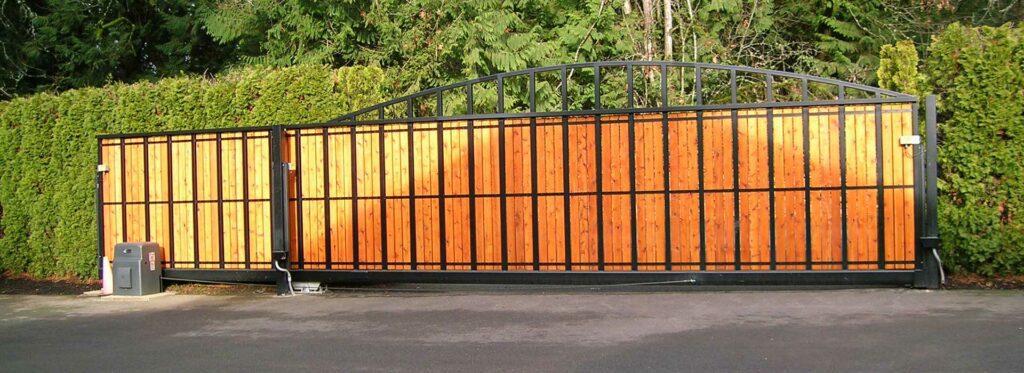
DJA provides inspiration for your designs and supplies top quality components. We can recommend highly skilled fabricators who use our components. Customers can also specify DJA specific components or designs to their fabricator or contractor.
Our office will be closed on Friday, July 4th in commemoration of Independence Day.
We will resume our regular activities on Monday, July 7th.
Sliding gates are a practical choice for securing your property.
These gates offer ease of use and take up less space compared to swinging gates.
If you’re considering installing a sliding gate, you’ll need the right kit and hardware to ensure it operates smoothly.

A sliding gate kit includes all the necessary components for installation and operation.
Choosing the right kit for your needs depends on several factors, such as the size and weight of your gate.
By understanding the basics, you can confidently select and install your sliding gate.
For a successful installation, follow the guide closely and ensure all parts are in place.
Proper maintenance and repair are crucial to keep your sliding gate in good working condition.
Regular inspections help prevent issues and ensure safety and compliance.
Sliding gates offer an efficient, space-saving solution for both residential and commercial properties.
They come in different types, each with unique benefits and specific components.
Manual Sliding Gates: These are operated by hand. They’re simple with fewer parts, requiring less maintenance. Ideal for low-traffic areas.
Cantilever Gates: These gates slide open without needing a track on the ground. Instead, they hang on rails beside the gate. They’re great for rough terrain.
Telescopic Sliding Gates: These gates consist of multiple panels that slide into each other. They save space by reducing the overall length required to open fully.
Sliding gates are space-efficient because they don’t swing outwards, making them perfect for properties with limited space.
They provide better security and are harder to force open compared to traditional gates.
Automated sliding gates also add convenience, allowing you to open them without leaving your vehicle.

Choosing the right sliding gate kit requires careful consideration of gate size, weight, material, and security levels.
To choose the correct sliding gate kit, measure your gate’s width and height. This helps ensure the kit you pick can handle the gate size.
Next, consider the gate’s weight.
Heavier gates need stronger hardware.
A lightweight gate might need less robust materials. Make sure to check the weight limits of the kits you are evaluating.
Your gate’s size and weight are vital factors in ensuring durability and smooth operation.
Different materials offer varying levels of durability and elegance. Common gate materials include wood, steel, aluminum, and vinyl.
When choosing material, consider weather conditions and desired maintenance levels.
Steel is best for heavy-duty needs, whereas aluminum suits lighter, easy-to-maintain gates.
Understand the security level your property needs.
A high-security gate should use strong materials and tough hardware.
Evaluate the security features of gate kits, such as lock types and automation options.
For instance, automated gates with keypad entry offer enhanced security for commercial and industrial properties.

Sliding gate kits include several key components to ensure smooth operation and functionality. These parts work together to automate and support your gate system effectively.
Gate tracks and rollers are essential. The gate track is the path along which the gate moves. It needs to be sturdy and durable. Common materials are steel or aluminum.
Rollers are wheels that fit into the track, allowing the gate to glide easily.
High-quality rollers reduce friction and noise. They often come with bearings to ensure smooth movement.
Proper installation of tracks and rollers is critical to prevent misalignment and ensure the gate operates smoothly.
Gate motors are the driving force behind automated sliding gates. They provide the power needed to move the gate.
Gate motors vary in size and power, depending on the gate’s weight and length.
Common motor types include AC or DC motors. Some kits include remote controls, keypads, or sensors for added convenience.
Gate automation systems often have safety features like obstacle detection and manual override to ensure user safety.
Brackets, stops, and guides provide support and limit the movement of the gate.
Brackets attach the gate to the rollers or track, ensuring stability.
Gate stops prevent the gate from moving beyond a certain point, protecting it from damage.
Gate guides keep the gate aligned during operation. They can be mounted on the ground or overhead.
These components are crucial for smooth operation and longevity. Proper installation ensures your gate operates without issues for years.
To install a sliding gate kit, you need to prepare the site, follow specific steps, and test the installation for any issues. Here’s how to handle each part of installing your sliding gate kit.
Gather Your Tools: Collect all necessary tools such as a drill, wrenches, measuring tape, and bolts.
Ensure you have all components from the gate kit.
Check the Site: Measure the area where you will install the gate. Ensure the ground is level.
If not, you may need to make adjustments or level the ground.
Install Gate Posts: Place and secure the gate posts firmly. Use concrete for better stability.
Allow the concrete to set before attaching the gate.
Step 1: Position the Gate Posts: Mark the spots where the posts will go. Dig holes deep enough for the posts.
Make sure they are level and straight before setting them in concrete.
Step 2: Mount the Track: Attach the track to the ground between the gate posts.
Ensure it is level using a spirit level to avoid issues with the gate’s movement.
Step 3: Attach Rollers and Brackets: Fix the rollers and brackets to the gate. Ensure they are securely fastened. Double-check that all bolts are tight.
Step 4: Install the Gate: Place the gate onto the track. Guide the rollers into position.
Ensure the gate moves smoothly along the track without obstruction.
Test the Gate: Slide the gate open and closed. Check for smooth operation.
If the gate sticks, adjust the track or rollers.
Check Alignment: Ensure the gate remains level throughout its movement. Misalignment could cause wear and tear or operational issues.
Inspect Hardware: Verify that all bolts and screws remain tight after initial use.
Re-tighten if necessary. Regular maintenance can prevent problems.
Turning a manual sliding gate into an automatic one can make your life easier and add convenience to your home. You need the right equipment and careful installation to ensure the system works smoothly.
When selecting a gate motor, consider the weight and size of your gate. Heavier gates need stronger motors.
Check the motor’s weight limit and choose one that exceeds your gate’s weight by a small margin to ensure durability.
Gate motors come in various types, including AC and DC motors.
AC motors are powerful but may need more maintenance. DC motors are quieter and often have battery backups.
Look for features like remote controls and safety sensors to avoid accidents.
Finally, go for well-known brands with good reviews. Reliable brands ensure fewer breakdowns and better support if issues arise.
Before starting, check that your gate moves easily on its track. Clean and lubricate the track to prevent motor strain.
If the gate isn’t moving smoothly, fix the mechanical issues first.
Mount the motor following the manufacturer’s instructions. Typically, you’ll install it on a concrete base for stability.
Align the motor with the gate to ensure it opens and closes properly.
Connect the motor to a power source, usually 110V or 220V, depending on the motor type.
Install safety sensors near the gate’s base to stop it if something blocks the path.
Test the system several times to make sure it operates correctly and make any needed adjustments.
Keeping your sliding gate in top condition ensures smooth operation over time. Regular maintenance and addressing common issues promptly can prevent larger problems.
Inspect the tracks and wheels: Debris and dirt can clog the tracks. Clean them regularly to prevent obstruction.
Check the wheels for signs of wear and replace if necessary.
Lubricate moving parts: Use a suitable lubricant on the tracks, wheels, and hinges to reduce friction and noise.
Avoid over-lubrication as it can attract dust.
Check the gate alignment: Ensure the gate moves smoothly and remains properly aligned. Misalignment can cause strain on the motor and other components.
Test the motor and controls: Regularly test the motor and remote controls to ensure they are working correctly. Replace batteries in the remote when needed.
| Task | Frequency |
|---|---|
| Inspect tracks and wheels | Monthly |
| Lubricate moving parts | Every 3 months |
| Check gate alignment | Every 6 months |
| Test motor and controls | Every 3 months |
Gate not opening or closing: This often indicates a power issue. Check the power supply and connections.
If the motor is unresponsive, it might need professional repair.
Noisy operation: Noise usually points to dry or worn-out components. Lubricate the necessary parts.
If the noise persists, inspect wheels and tracks for damage.
Gate stuck in tracks: Debris or misalignment can cause this. Clear the tracks and realign the gate if needed.
Damaged tracks may need replacement.
Weather damage: Severe weather can affect gate durability.
Inspect for rust or corrosion, especially on metal components. Use rust-resistant coatings or replace affected parts.
Slow movement: This can result from motor strain or improper lubrication.
Ensure all parts are well-lubricated and check the motor for signs of wear. Consult a professional if the issue continues.

When setting up a sliding gate, you must follow local building codes and ensure safety during use. This will prevent accidents and ensure your installation is legal.
You need to check your local building codes before installing a sliding gate. These codes vary depending on your location.
They often include guidelines on gate size, height, and materials. Permits might be required before starting the installation.
Failure to follow these codes can lead to fines or complications.
It’s best to contact your local building department for the exact requirements.
Some areas may have restrictions on motorized gates or specific safety features that must be included. Always get this information beforehand for a smooth installation process.
Safety is crucial when using a sliding gate. Ensure that all components are secure and regularly maintained.
Install safety sensors to detect obstacles. These sensors will prevent the gate from closing on people, pets, or objects.
Always keep children away from the moving parts of the gate.
Make sure there are clear warning signs near the gate. Proper lighting is also essential, especially at night.
Regularly check the gate’s motor and other mechanical parts to avoid malfunctions. If issues arise, call a professional for repairs.

Adding accessories to your sliding gate can enhance its functionality and appearance, making it more convenient and elegant.
Selecting suitable accessories is crucial for optimal gate performance.
Latches secure the gate when closed, preventing unwanted access. Look for sturdy and weather-resistant options for durability.
Wheels and guide rollers ensure smooth operation. Choose high-quality materials like stainless steel for longevity.
Consider adjustable rollers to maintain proper alignment and reduce wear.
Handles provide convenience. Opt for ergonomic designs for ease of use. Adding locking mechanisms can further enhance security.
Sensors automate gate operation, adding convenience. Select reliable and easy-to-install models to improve daily functionality.
Visual enhancements can elevate your gate’s look.
Adding decorative hardware like ornate latches or handles can boost elegance.
Consider paint or finishes that complement your property. Weather-resistant options maintain appearance despite exposure to the elements.
Lighting enhances both aesthetics and security. Install stylish fixtures along the gate path for a pleasing effect.
You can also plant landscaping elements around the gate area. Flowers or shrubs can create a welcoming appearance.

Sliding gate kits and supplies are available both online and in-person, with options ranging from simple DIY kits to specialized hardware for larger projects.
Big Box Retailers: Stores like Home Depot offer a selection of sliding gate kits suitable for small, DIY projects. These options are convenient and often come with customer reviews to help inform your purchase. However, for more complex or high-use applications, specialized components are necessary.
Local Hardware Stores: You may also find basic supplies at smaller, local stores. Calling ahead or checking online can save you a trip, but remember that the selection may be limited to simpler installations.
Online Retailers: Shopping platforms such as Amazon or eBay provide a wide range of sliding gate hardware. While it’s easy to compare prices and read reviews, sourcing specialty-grade components for demanding projects is usually better done through a supplier.
For larger or more complex installations, specialty hardware from suppliers like DJA is essential to ensure reliability and long-term performance. All the components you need for professional-grade gate systems can be sourced through our comprehensive selection.
Sliding gate kits come with various components, materials, and mechanisms that can impact their functionality and maintenance.
A sliding gate kit usually includes the gate itself, a motor, wheels, a track, and remote controls. You’ll often get safety sensors and mounting hardware as well.
Consider the weight and size of the gate to match the motor’s strength.
Look into the power source and check for features like remote access and safety sensors.
Make sure the opener is designed for commercial use.
Common materials include steel, aluminum, and wood.
Steel gates are very strong and last long but need maintenance to prevent rust.
Aluminum gates are lighter and don’t rust, making them easier to maintain. Wood gates look good but require more upkeep.
A sliding gate often has a locking pin or electric lock that activates when the gate is closed. Some systems use a magnetic lock that engages when the gate aligns with the receiver.
Regular maintenance includes lubricating the wheels and track, checking the motor, and ensuring all bolts are tight.
Look for rust on metal parts and clean them. Routine checkups will keep the gate functioning well.
The number of wheels affects how well the gate moves. More wheels usually mean smoother movement and less wear on each wheel.
For heavier gates, having more wheels can help distribute the load better, making it easier to operate.
DJA provides inspiration for your designs and supplies top quality components. We can recommend highly skilled fabricators who use our components. Customers can also specify DJA specific components or designs to their fabricator or contractor.